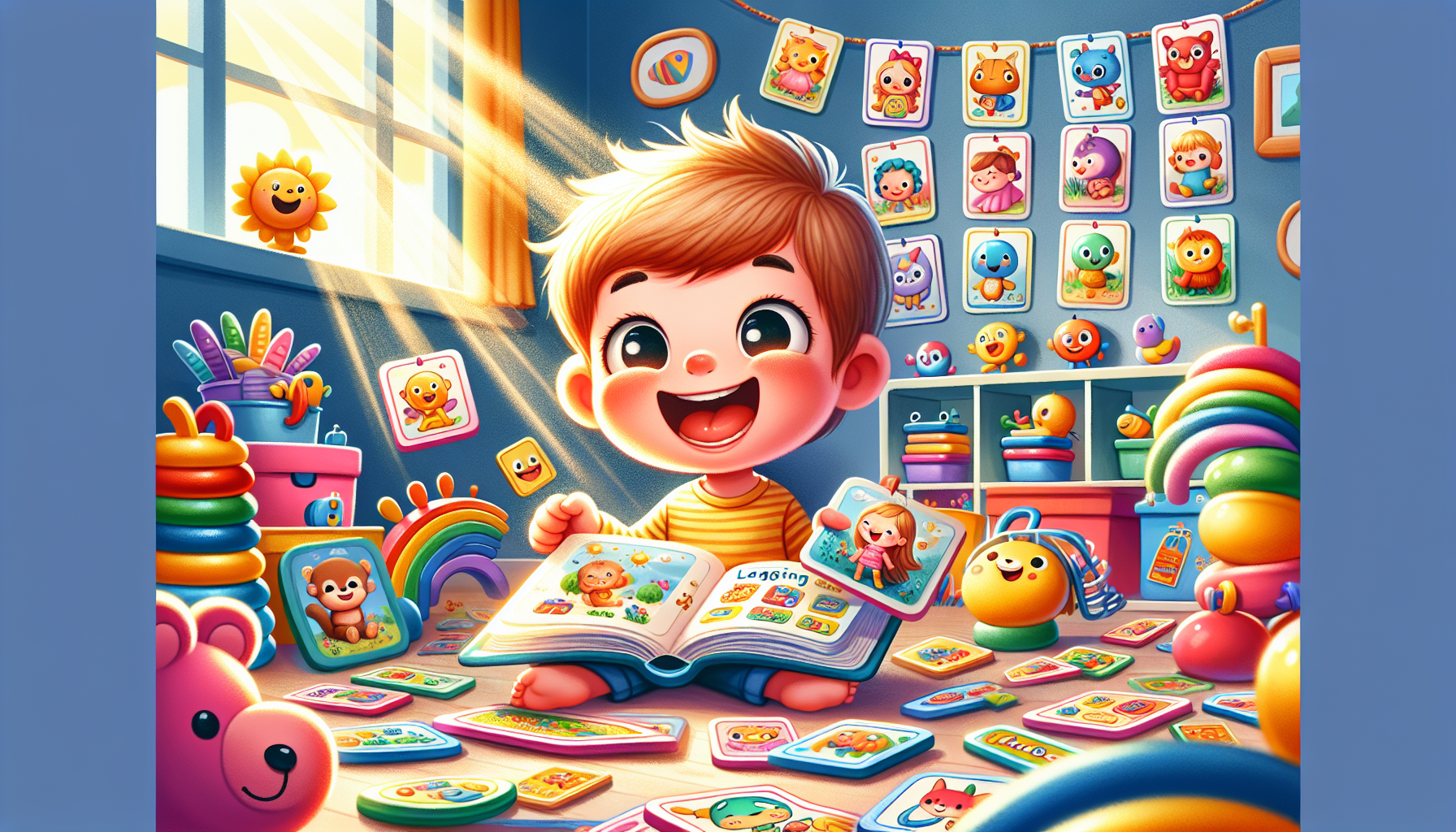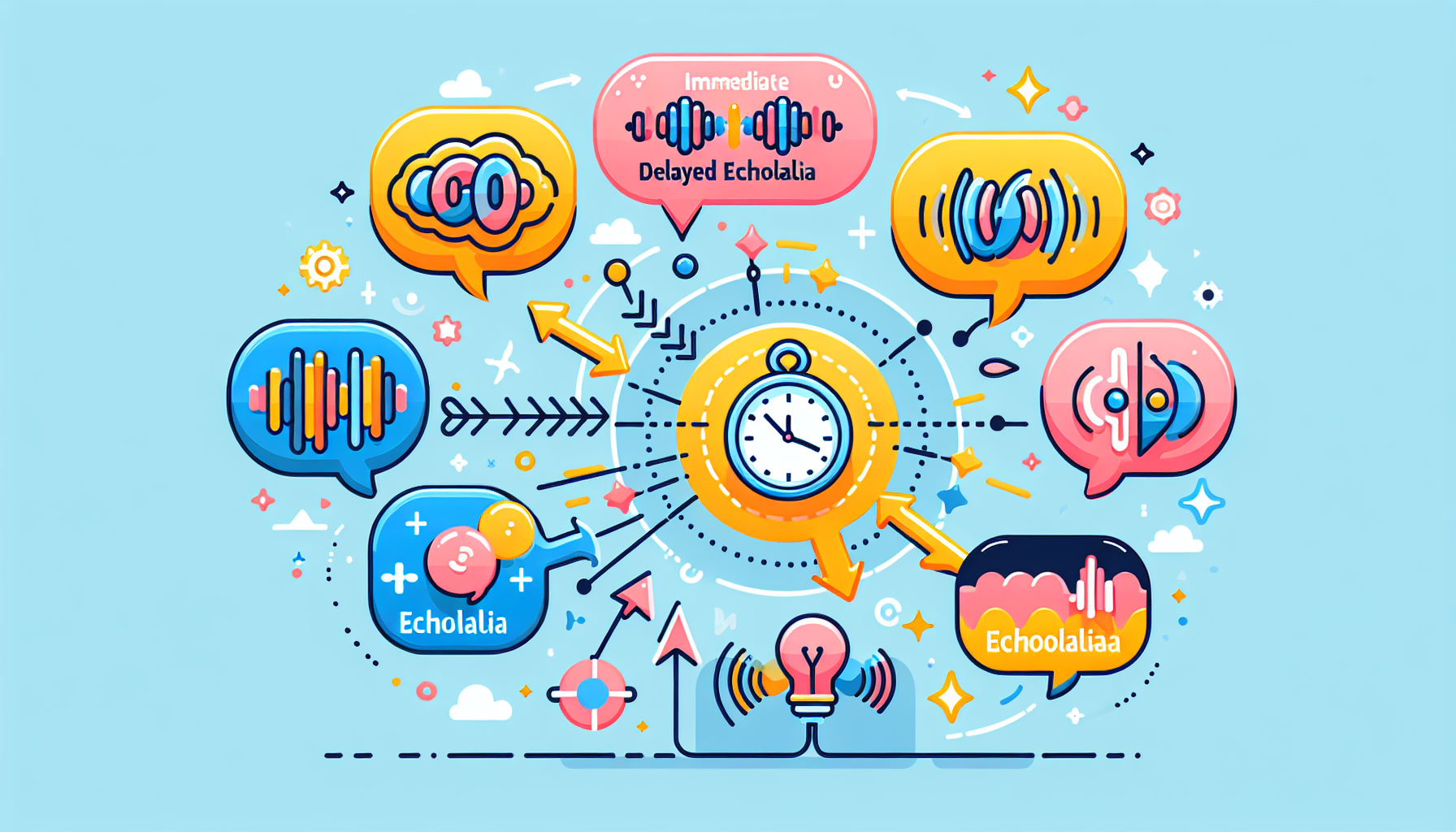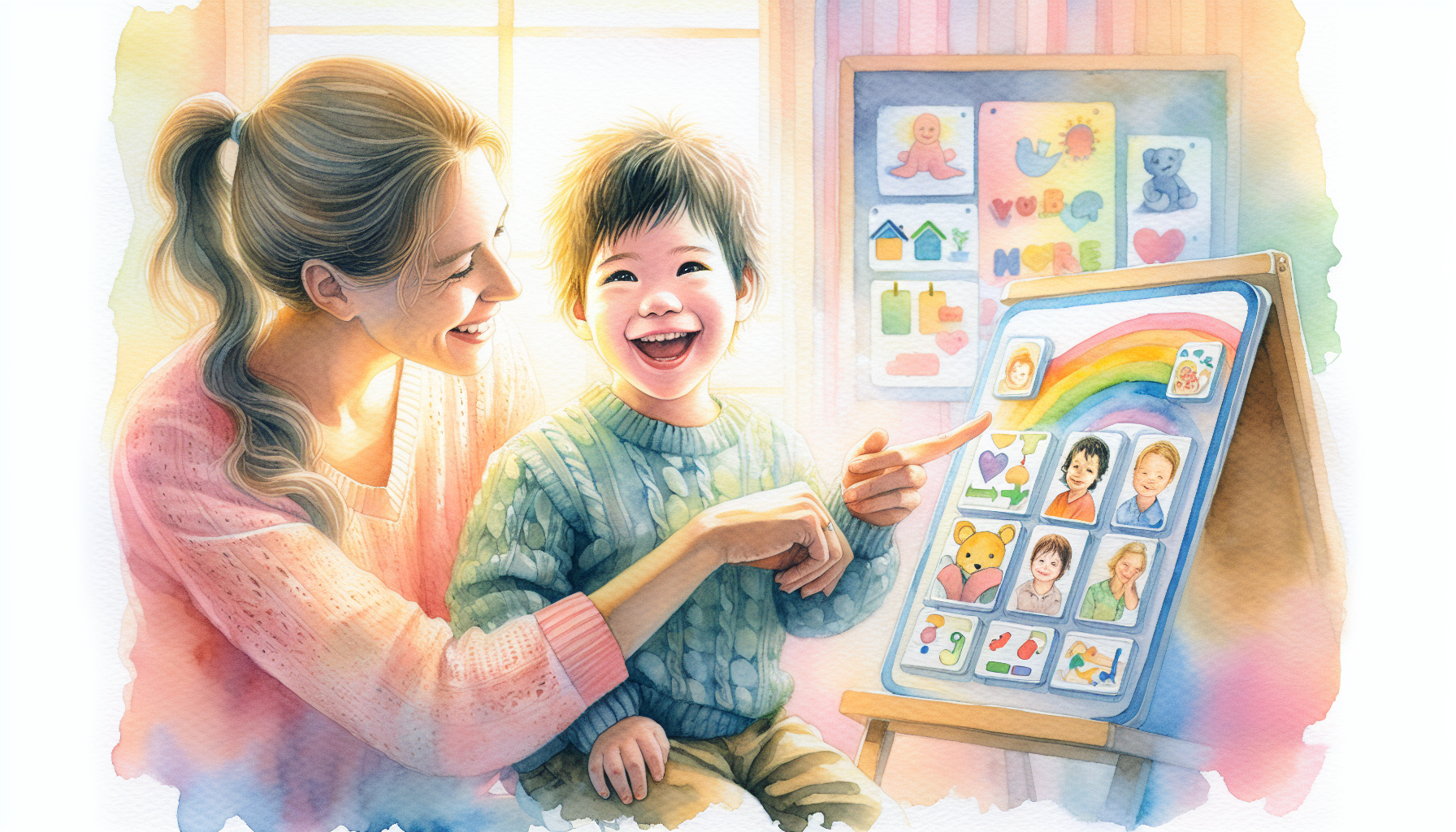Echolalia is the repetition of words or phrases that someone hears. It often occurs in autism and can be a way to process language and communicate. In this article, we will discuss the types, causes, and treatments of echolalic behavior.
Key Takeaways
- Echolalia is the automatic repetition of words or phrases and plays a significant role in language acquisition, particularly for children with autism.
- There are three primary types of echolalia: immediate, delayed, and mitigated, each serving different functions in communication and language processing.
- Effective treatments for echolalia include speech therapy, behavioral therapy, and the use of assistive devices, with an emphasis on creating structured, supportive environments to reduce anxiety.
Understanding Echolalia

Echolalia is defined as the automatic repetition of words or phrases that individuals hear from others. The term originates from Greek, where ‘echo’ means to repeat and ‘lalia’ means speech. This phenomenon is more than just a quirky trait; it is an essential part of language acquisition, especially for young children. Repeating sounds and phrases helps children form words and sentences, building the foundation of their language skills.
In children with autism, echolalia takes on an added significance. While it might appear as merely repetitive speech, echolalia can serve as a meaningful tool for communication. For these children, repeating words or phrases can be a way to process language, express needs, or engage with others. Recognizing the role of echolalia in speech and language development is crucial for supporting children as they navigate their linguistic journey.
As we dive deeper, we will explore the different types of echolalia and how they manifest in various contexts. Recognizing these distinctions can help in developing targeted interventions that enhance a child’s ability to produce spontaneous speech and engage more effectively with their surroundings.
Types of Echolalia

Echolalia can be categorized into three main types:
- Immediate echolalia, which involves the repetition of phrases or parts of phrases right after hearing them.
- Delayed echolalia, which occurs when the repetition happens after a significant time delay, often recalling phrases heard in the past.
- Mitigated echolalia, which is characterized by slight alterations in the repeated phrases.
Recognizing these distinctions is vital for understanding how echolalia functions in communication and language processing.
Immediate Echolalia
Immediate echolalia refers to the behavior where individuals repeat words or phrases they have just heard. This type of echolalia is often seen in children with autism, who might echo back phrases immediately after they hear them. For instance, if you say, “Do you want an apple?” the child might repeat, “Do you want an apple?” before responding. This behavior can be a way for the child to process the question or simply engage in automatic speech imitation.
While it might seem like mere mimicry, immediate echolalia can also be a stepping stone in language development. Repeating words or phrases can help children practice language structures and improve their speech and language development.
Recognizing that this type of echolalia is not just a barrier but an integral part of language acquisition is crucial.
Delayed Echolalia
Delayed echolalia, on the other hand, involves the repetition of words or phrases after a significant time has passed. This could mean hours, days, or even weeks after the original phrase was heard. For example, a child might repeat a line from a favorite TV show days after watching it. This type of echolalia can sometimes serve as a coping mechanism, helping children recall comforting or significant phrases during times of stress or uncertainty.
Delayed echolalia also plays a role in language development. Recalling and repeating phrases reinforces how a child’s language skills develop and allows them to practice speech patterns. However, it can also indicate underlying communication disorders or developmental delays, especially if it persists beyond the typical age range for language development.
Mitigated Echolalia
Mitigated echolalia refers to when repeated phrases are changed slightly during repetition. For instance, a child might hear the phrase, “Let’s go to the park,” and later say, “Let’s go park.” This slight alteration indicates that the child is processing and understanding language, even if the repetition is not exact.
Mitigated echolalia can also help reduce anxiety in children. Slightly altering phrases allows children to express their understanding and make the language more their own. This form of echolalia reflects a higher level of language processing and can be a positive sign in a child’s language development journey.
Echolalia in Autism Spectrum Disorder (ASD)

Around 75% of children with autism exhibit echolalic behaviors during their language development. While echolalia might initially seem like a barrier to communication, it can serve as a crucial tool for autistic children. Recognizing the intent behind echolalic speech is essential for providing effective support. For instance, repeating words or phrases can be a way for autistic children to process language, express their needs, or engage with others.
However, the repetitive nature of echolalia can lead to misunderstandings in social contexts, impacting relationships and self-esteem. Children with echolalia often encounter difficulties in engaging with peers and forming friendships due to these communication barriers.
Understanding echolalia’s role in autism spectrum disorder can help caregivers and educators develop strategies to support meaningful communication and social interactions.
Communication Development in ASD
Echolalia can serve as a stepping stone in language acquisition, often evolving into more structured forms of speech as comprehension improves. For children with autism spectrum disorders, echolalia can be a way to process spoken language, requiring more time to understand and respond. Immediate echolalia, where children repeat words or phrases they just heard, is common and can include incorrect pronoun usage.
Mitigated echolalia, characterized by slight alterations in repeated phrases, reflects a growing language understanding. Visual aids can significantly enhance vocabulary and comprehension for children with echolalia, helping them understand verbal instructions and anticipate changes. These tools provide clarity, enabling children to better grasp vocabulary and enhance their overall understanding.
Functional Uses of Echolalia in ASD
Echolalia can be categorized as functional, aimed at communication, or non-interactive, occurring without the intent to communicate. Functional echolalia can serve various purposes, including processing language and indicating readiness for conversation. For example, an autistic child might repeat a question to signal they are ready to answer or need more time to respond.
Additionally, echolalia can function as a method for self-regulation, helping children manage their emotions and responses. Repeating familiar phrases helps children soothe themselves and navigate stressful situations.
Recognizing the functional uses of echolalia helps caregivers and educators support autistic children in using echolalia as a communicative tool rather than viewing it as a mere repetitive behavior.
Causes of Echolalia
Echolalia is often a sign of developmental disability, particularly if it continues in children older than three years. Around 75% of children diagnosed with autism exhibit echolalia, making it a common characteristic of developmental delay. However, echolalia can also be a symptom of various neurological conditions, including seizures and brain injuries.
Psychiatric disorders, such as anxiety and schizophrenia, can exacerbate echolalic behavior. Understanding the diverse causes of echolalia is crucial for developing effective interventions and support strategies. Recognizing that echolalia can stem from multiple sources highlights the need for comprehensive evaluations to determine the underlying causes and provide targeted treatments.
Autism Spectrum Disorder
Echolalia is strongly associated with autism spectrum disorder (ASD). This behavior involves repeating words or phrases and is commonly observed in individuals with ASD. Understanding this association can aid in the development of targeted interventions that support communication.
Children with autism often use echolalia as a way to process language and engage with others. Recognizing echolalia as a characteristic of ASD helps caregivers and educators develop strategies to support meaningful communication and social interactions.
Tourette Syndrome and Other Conditions
Tourette syndrome is a neurological condition that can lead to involuntary verbal and motor tics, and echolalia can occur as part of these symptoms. In Tourette syndrome, echolalia often manifests as involuntary repetition of words or phrases, which can be a component of the tics.
Echolalia can also indicate various neurological issues, including strokes and psychiatric disorders, which may overlap with conditions like Tourette’s syndrome. Recognizing the diverse conditions that can lead to echolalia is essential for providing comprehensive care and support.
Impact on Daily Life

Echolalia can serve as a tool for verbal communication, helping to bridge gaps in expression. Children with echolalia often use scripting during social interactions, particularly when they are unsure of what to say. However, echolalia can also interfere with meaningful communication, making it challenging for children to express their thoughts clearly.
The impact of echolalia on daily life can be significant. It may hinder understanding and responding to classroom instructions, affecting learning outcomes. Providing access to support and resources can enhance the lives of children with echolalia. A nurturing community also plays a crucial role in this improvement.
Organizations focused on echolalia aim to enhance the lives of children affected by this behavior through various support mechanisms.
Treatments and Interventions

Effective support for children with echolalia requires focusing on individual communication needs. Engaging in structured activities and implementing consistent schedules can foster meaningful communication, reducing anxiety associated with echolalia.
In educational settings, teachers may need additional training to support students using echolalia effectively.
Speech Therapy
Speech therapy is a vital intervention for children with echolalia. It helps children understand and support communication by reducing repetitive speech. A speech language pathologist can utilize techniques like verbal modeling combined with prompting to effectively encourage spontaneous speech in children exhibiting echolalic behavior. Speech language pathologists stand can play a crucial role in this process.
Using starter sentences can also promote spontaneous speech, helping children fill in the blanks with their words. These techniques collectively enhance the child’s ability to communicate effectively and reduce reliance on echolalic phrases.
Behavioral Therapy
Behavioral therapy plays a crucial role in managing echolalic behavior. Applied behavior analysis (ABA) techniques are often employed to help individuals learn to use language more functionally. Improving communication through these techniques takes time and requires consistent repetition.
Remember that progress in behavioral therapy may be slow but steady. Consistency and patience are key to helping individuals with echolalia develop more effective communication skills.
Use of Assistive Devices
Assistive devices, such as AAC devices, provide a visual and tactile means of communication for individuals with echolalia. These devices enable individuals to express their needs and thoughts more effectively. The Picture Exchange Communication System (PECS) can also facilitate meaningful communication for individuals with echolalia.
Using AAC devices and PECS enhances communication opportunities, making it easier for individuals with echolalia to interact with others and express themselves.
Practical Tips for Parents and Educators
Routine and structure in daily activities can help children with echolalia feel more secure and less anxious. Creating a supportive environment is essential. Implementing consistent daily schedules can enhance the comfort level of children with echolalia, leading to improved communication and social interactions.
Visual Supports
Visual supports are essential tools that can significantly enhance communication skills for those exhibiting echolalic behavior. Visual cues such as picture cards, illustrated schedules, and gesture prompts can improve vocabulary and comprehension for individuals with echolalia. These tools provide clear and consistent cues that help children understand and process language, making it easier for them to respond appropriately.
Incorporating visual supports into daily routines helps parents and educators create a more inclusive and supportive environment. Visual aids not only assist in language development but also help in reducing anxiety by providing predictable and understandable means of communication. This approach ensures that children with echolalia are better equipped to navigate their interactions and express themselves more clearly.
Modeling and Prompting
Modeling and prompting are effective techniques for encouraging spontaneous speech in children with echolalia. Verbal modeling allows adults to provide examples of appropriate speech for children to imitate. For instance, asking choice questions like “Do you want an apple or a banana?” encourages engagement and prompts the child to make a choice, reducing echolalia.
Gradually introducing ‘WH’ questions after practice with choice questions can further promote spontaneous speech. Following through on children’s answers helps reinforce language lessons and identify objects by name, providing a solid foundation for natural language development.
These techniques, combined with patience and consistency, can significantly improve communication skills in children with echolalia.
Reducing Anxiety
Creating a calm environment can significantly reduce anxiety for individuals who exhibit echolalic behavior. Incorporating soothing colors and calming sounds in the environment can further enhance tranquility, helping to mitigate anxiety. Identifying and minimizing external stressors, such as loud noises or chaotic settings, is crucial in creating a supportive atmosphere for individuals struggling with echolalia.
Implementing relaxation techniques, such as deep breathing exercises or mindfulness practices, can effectively reduce feelings of anxiety. Physical activities such as yoga or stretching can also serve as beneficial strategies to promote relaxation.
Establishing a consistent daily routine helps provide a sense of stability, thereby reducing anxiety and potential echolalic reactions.
Summary
Echolalia, often perceived as a repetitive and disruptive behavior, holds a deeper significance in the realm of language development and communication. By understanding its types, causes, and impacts, we can appreciate echolalia as a valuable tool for children, particularly those with autism spectrum disorder. Immediate, delayed, and mitigated echolalia each play a unique role in language processing and development.
Effective treatments and interventions, such as speech therapy, behavioral therapy, and the use of assistive devices, can significantly enhance communication skills and quality of life for individuals with echolalia. Practical strategies for parents and educators, including the use of visual supports, modeling, and anxiety reduction techniques, further empower children to navigate their linguistic journey with confidence. Embracing these approaches fosters a supportive environment where children with echolalia can thrive.
Frequently Asked Questions
What is echolalia?
Echolalia is the automatic repetition of words or phrases heard from others, frequently observed in language development and notably among children with autism spectrum disorder. This phenomenon serves as a communication method, reflecting the individual's processing of language.
What are the types of echolalia?
Echolalia is categorized into immediate, delayed, and mitigated forms. Immediate echolalia occurs right after hearing, delayed echolalia happens after a considerable time, and mitigated echolalia entails slight changes in the repeated phrases.
How does echolalia affect children with autism?
Echolalia can be a beneficial communication tool for children with autism, aiding in language processing and expression of needs. Nevertheless, it may also create difficulties in social interactions and clarity of communication.
What treatments are available for echolalia?
Effective treatments for echolalia encompass speech therapy, behavioral therapy, and assistive devices such as Augmentative and Alternative Communication (AAC) and Picture Exchange Communication System (PECS). These interventions focus on improving communication skills and decreasing dependency on echolalic phrases.
How can parents and educators support children with echolalia?
To effectively support children with echolalia, parents and educators should utilize visual aids, modeling, and prompting to foster spontaneous communication. Additionally, a calm environment combined with consistent routines can alleviate anxiety and further facilitate verbal expression.
Original content from the Upbility writing team. Reproduction of this article, in whole or in part, without credit to the publisher is prohibited.









